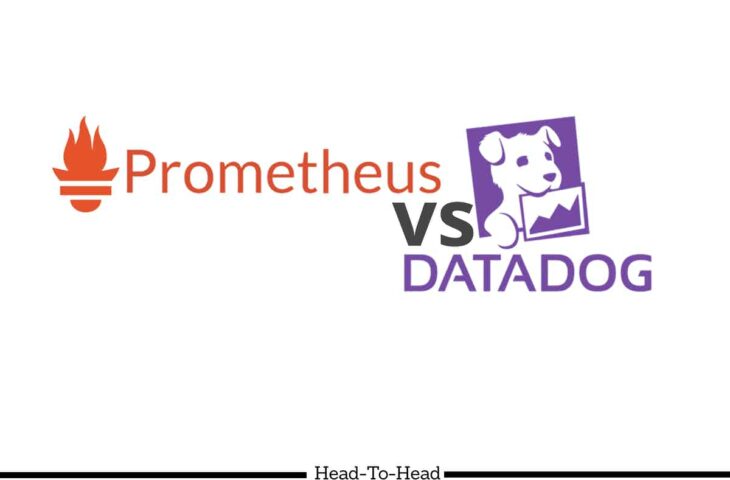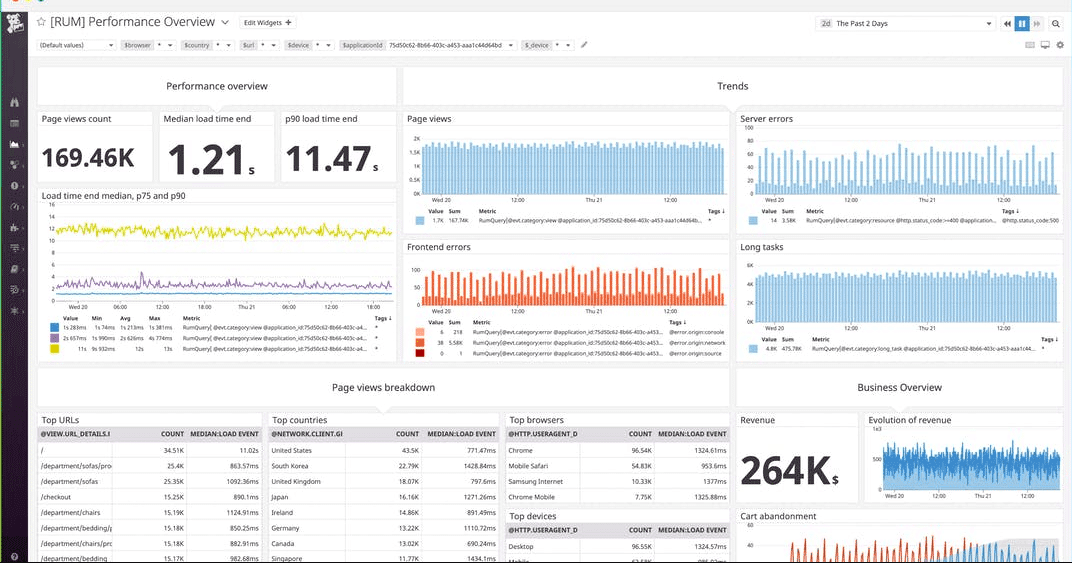We may earn a commission if you make a purchase through the links on our website.
Prometheus Vs Datadog

UPDATED: March 31, 2023
If you're in the IT sector and looking for monitoring tools to analyze your applications, then you must have heard about Prometheus and Datadog. This post will help compare the two most popular monitoring tools and conclude which one is more suitable for your business.
Many companies use these two tools to monitor their container and microservice estates and applications to identify errors and security threats.
Our guide provides a head-to-head comparison between both the products based on User Interface, Cost, Monitoring capabilities, and more. However, before we go through each sub-category, let us brief on monitoring tools.
What is Monitoring Tools?
Today, Application Development has become a vital process for many businesses. It has become significant to automate business processes and increase efficiency. As a result, the launch of new software and applications is visible in the marketplace. Experts are looking forward to providing more quick and better updates for a good user experience. This, in turn, further enhances the chances of application bugs and issues in the system. To keep track of errors, bugs, and other issues in the application, IT experts recommend a more technical approach – the exercise of monitoring tools. For an entrepreneur, going through each detail will require a lot of time and effort. Thus, it is better to surround yourself with the best monitoring tools or hire an expert to identify and fix these bugs or issues.
Prometheus and Datadog are some of the most popular monitoring tools in the current time.
What Prometheus and Datadog do?
Operators exercise monitoring tools, such as Prometheus and Datadog, to scan bugs, find system issues and keep your application out of risk. These essential tools are best suitable for enterprises that wish to track multiple applications, diagnose performance issues, identify coding errors, discover critical bugs, and more.
Prometheus is a monitoring tool that collects and stores real-time metrics in a time series database with unique metric names and key-value pairs for recognition. With every accumulated metric, it makes it easier for the operator to analyze and understand the state and trajectory of your system. However, this monitoring tool is not suitable for all applications, especially those requiring high accuracy, such as a billing application.
Datadog, on the other hand, monitors, troubleshoot, and optimizes the application performance by the current goal. In addition, it tracks application performance and uses open-source tracing libraries to ease the complete process.
Further, both the monitoring tools generate graphs and alerts on error rates that might negatively impact the user experience.
Prometheus Product Highlights

Prometheus is an open-source application developed at SoundCloud for a cloud-based, containerized world. The tool is best used for monitoring and alerting. Earlier created in 2012, the monitoring tool became part of the Cloud Native Computing Foundation in 2016 and 2018. Prometheus’ design and capabilities help gather metrics about Kubernetes clusters using time series data. The tool at times fails to collect perfectly tailored data which is why it also depends on some third-party plugins for accurate graphs, tables, and alerts. The monitoring tool focuses mainly on metrics, not logs. Further, it is a great tool and helps with quick outage detection.
Key Features
- A multi-dimensional data model collects and stores its metrics in time series recognized by metric names and key-value pairs.
- The pull model helps in the time series collection.
- PromQL, a Query Language, helps aggregate time-series data into tables, graphs, and alerts.
- Prometheus uses an in-built expression browser, third-party plugins, such as Grafana, and console templates, to visualize data.
- It has an efficient storage system.
- Independent server nodes. No dependence on network storage or any other remote service.
Pros:
- A free open-source tool
- Has a large community-driven repository of add-ons and hotfixes
- Can accommodate complicated Kubernetes environments
- Excellent dashboard metrics
Cons:
- Open source isn’t always the best solution for enterprise companies
Datadog Product Highlights

Datadog is one of the leading monitoring tools with 350 built-in integrations. The cloud-based network monitoring tools give developers and IT experts the benefit to track, troubleshoot, and optimize application and cloud-based platforms. Further, it collects data from various sources to generate log data and provide alerts. The toolkit monitors bugs and changes visible on the website and accordingly generates a performance report.
Key Features
- Easy to monitor frontend, backend, and business analytics on one screen
- Data aggregation
- Can Create Custom Alert
- Full Access to an Application programming interface
- Monitor end-to-end user experience
- Customizable monitoring dashboards
- Team collaboration tools
Pros:
- Offers numerous real user monitors via templates and widgets
- Can monitor both internally and externally giving network admins a holistic view of network performance and accessibility
- Changes made to the network are reflected in near real-time
- Allows businesses to scale their monitoring efforts reliably through flexible pricing options
Cons:
- Would like to see a longer trial period for testing
Feature Comparison Table: Prometheus Vs Datadog
| Features | Prometheus | Datadog |
|---|---|---|
| User Interface | It uses a third-party plugin - Grafana to create intuitive UI | No extra third-party plugin is needed |
| Monitoring Capabilities | Can monitor time-series for Kubernetes | Can monitor any infrastructure or application |
| Installation | The complicated process when intend to use the full features | Easy to Install |
| Support | Commercial support from Container Solutions, Grafana Labs, PromLabs | Email, Live Chat, In-app Event Stream messaging |
| Plugins | Provide slightly more third-party plugins in comparison to Datadog | Provide slightly fewer third-party plugins in comparison to Prometheus |
| OS Support | Linux, Mac OS X, FreeBSD (32-bit, 64-bit, and ARM) | Amazon Linux, Centos, Debian, Fedora, Ubuntu, and SUSE |
| Training | Documentation, Webinars, Live Online | Documentation, Webinar, Videos and Learning center |
| Cost | Free tool but a few companies provide it as a service | Free Trial, Pro - $15 per host, per month. Enterprise - $23 per host, per month |
Prometheus Vs Datadog Head-to-Head
User Interface
Prometheus exercises an in-built expression browser, third-party plugins, such as Grafana, and console templates to generate intuitive UI. In most cases, Grafana plays a vital role in data visualization, creating a dashboard with intuitive graphs and charts. If you are using a third-party tool Grafana for better reports and graphs, we would like to highlight two caveats about the same. Firstly, Grafana’s dashboard requires expert help to import successfully. Secondly, it lacks complex alerting logic and even basic event tracking. However, together they are highly powerful open-source tools that provide data collection and visualization, and basic alerting.
However, data visualization in Datadog is pretty straightforward. This monitoring tool uses an AI-powered automated browser for end-to-end visibility of your application. When comparing the two, we recommend Datadog UI as it does not have any third-party plugin to create UI.
Monitoring Capabilities
Both the monitoring tools have plus points that make it difficult for the operator to choose one. If you are looking to monitor time-series for Kubernetes, go with Prometheus. However, Datadog is an overall APM and can monitor any infrastructure or apps but is not designed for creative monitoring. With Datadog, one can watch frontend, backend, and business analytics on one screen, but it is challenging to do it with Prometheus.
Installation
Installing Prometheus at the initial stage is a quick process, but the task gets complicated if you are willing to add the full features of Prometheus. For example, one may need to install third-party plugins that complicate the installation process. On the other hand, Datadog comprises many in-built features that will meet your requirement. Thus, no need for an extra third-party plugin.
Plugins
Both products use third-party plugins to add more features and regular usage. But Prometheus provides slightly more third-party plugins in comparison to Datadog. Aerospike, Druid, CouchDB are some of the popular plugins used with Prometheus and Datadog.
OS Support
Prometheus supports Linux, Mac OS X, and FreeBSD (32-bit, 64-bit, and ARM) in terms of OS Support. In contrast, with the recently installed Window updates, Datadog Agent v6+ supports Amazon Linux, Centos, Debian, Fedora, Ubuntu, SUSE, and Windows Server 2008 R2.
Support
Datadog offers a wide range of support options, including email, live chat, and an in-app Event Stream messaging option to connect with the support team. On the other hand, Prometheus provides commercial support through platforms like Container solutions, Grafana Labs, PromLabs.
Training
The Linux Foundation, PromLabs, Robust Perception are the top platforms that provide Prometheus training. The training program involves an architecture overview and some of the main Prometheus features. Whereas, DevOpsSchool provide Datadog training to help learn the core fundamental and understanding the concepts.
In Datadog, Training is available through Documentation, Webinars, Live Online. However, Prometheus only provides Documentation.
Pricing
As an open-source tool, Prometheus is much more affordable than Datadog. Prometheus is a free tool, though many companies provide Prometheus as a service covering, hosted Prometheus, Graphite, and Grafana. Whereas, Datadog charges a minimum of $15 per month for one host and other services, including log management and APM. If you are willing to choose Prometheus from AWS, check out super-economical pricing and save your expenses. When comparing the two based on cost, Prometheus turns out to be a better choice. Again, though, the decision entirely depends on the requirement of your business, and Datadog is suitable for all applications and interfaces.
Prometheus vs. Datadog: The Verdict
Both the monitoring tools have great features and robust monitoring capabilities as per their use case. However, Prometheus turns out to be less costly than Datadog and is quick to install at the initial stage but only suitable for Kubernetes. On the other hand, Datadog is ideal for all applications and interfaces. Also, it helps deliver actionable insights and performance reports for better analysis and fixing the bug or any issue. Another feature of Datadog makes it easier for the operator to look into metrics history.
However, if you are looking forward to a tool that will help monitor any application from the backend or frontend, we recommend Datadog as the best choice. Ultimately, one must make a final decision based on specific business requirements.
Prometheus Vs Datadog FAQs
What are the key features of Prometheus?
The key features of Prometheus include real-time data collection, a powerful query language, alerting and notification capabilities, and scalability.
What are the key features of Datadog?
The key features of Datadog include real-time data collection, analytics and visualization capabilities, integrated monitoring, log management, and collaboration tools.
What are the benefits of using Prometheus?
The benefits of using Prometheus include its open-source nature, scalability, and powerful query language, which allows for efficient data analysis and alerting.
What are the benefits of using Datadog?
The benefits of using Datadog include its cloud-based architecture, integrated monitoring and analytics capabilities, and collaboration tools, which make it a comprehensive solution for monitoring and analyzing time-series data.
How does Prometheus compare to Datadog?
Prometheus and Datadog are both monitoring and alerting tools, but Prometheus is an open-source tool that focuses on real-time data collection and alerting, while Datadog is a cloud-based platform that provides a more comprehensive solution, including integrated monitoring, analytics, and collaboration tools.